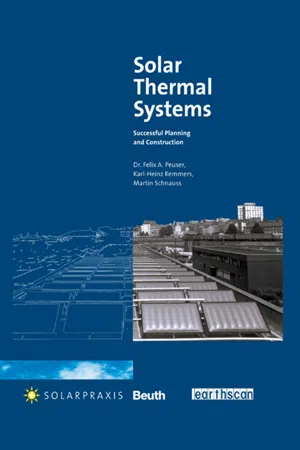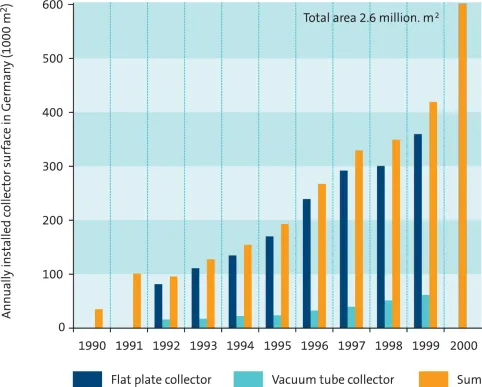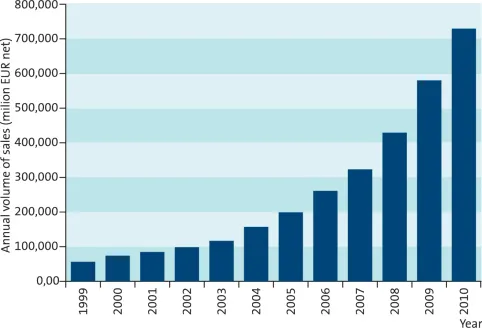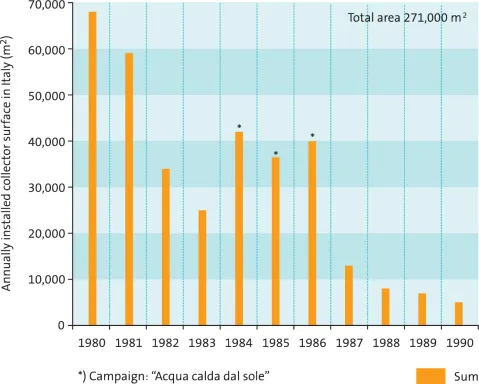![]()
1. Introduction and Basic Knowledge
1.1 Market Development of Solar Thermal Systems
Fossil energy sources are limited; crude oil and natural gas will be significantly depleted within the next 40 years due to the worldwide increasing demand. The continuous use of fossil fuel is leading to grave damag of our environment and to far-reaching climate changes.
In many arid countries, the use of firewood for cooking and water heating leads to deforestation, creation of steppes and erosion.
The 1972 Club of Rome report »Limits to Growth« and the first oil-price crisis of 1973 both attracted worldwide the attention to these problems. Consequently, they initiated the development of solar technology in many countries.
Solar power is an inexhaustible source for the permanent maintenance of our energy supply and wealth. During the next decades, solar technology will transform today’s structures of energy supply, especially since modern worldwide markets change rapidly.
1.2 Market Development in Europe
From 2002, many European countries have been intensifying their activities in the solar technology field. For instance, numerous countries have introduced environmental taxes and corresponding subsidy programmes for renewable energy technologies. Within the energy sector, the EU White Paper envisages an increase of renewable energy supplies to 12% throughout the EU by 2010.
The estimated related investment costs for this period are about 165,000 million Euros, the associated creation of 500,000 jobs predicted. Additionally, by 2010, an annual export market of 17 000 million Euro is estimated, with the opportunity of 350,000 additional jobs. /3/
These ambitious aims are being met by different EU states with market stimulating programmes.
1.2.1 Germany
Regarding the technology of solar thermal systems, Germany is a worldwide market leader. The USA and Japan are progressive in the field of solar electricity generation. All three countries are striving to obtain the leading position.
In Germany, a stable governmental subsidy for solar thermal installation was first established in 2000. Also that year, a stable and sensible subsidy for solar photovoltaic production was introduced with the »Act on Granting Priority to Renewable Energy Sources«. This new law led to increased market activity. The Act was advantageous for German solar technology to become well known and to top the league in worldwide turnover.
Recent market estimations are for 30% annual growth in association with reducing prices.
Therefore, almost all significant suppliers in the fields of heating technology, of roof and façade building (e.g. VIESSMANN, BUDERUS, Braas Dachsysteme, SCHÜCO), and various oil companies (e.g. BP, Shell, Total) invested in the development of solar technology.
All trade professions (e.g. sanitary, heating, roofing, joinery, repairs, façade building, electrical) recognized the growth of the market in utilising renewable energy sources and are starting to invest in the market. Planners and architects subsequently followed the trend.
The past market development of solar thermal installations in Germany can be seen in Figure 1.1.
Figure 1.1 Collector area annually installed in Germany (source: DFS e.V. /3)
Figure 1.2 Turnover forecast in the solar thermal field according to different surveys made by DFS e.V. /3/; own calculations
1.2.2 Austria
Recently, Austria met about 25% of the whole energy demand with renewable energy sources.
Besides the use of hydropower, traditional wood-heating stoves are very common.
High environmental awareness, highly developed technology (also in and due to combination with wood-heating stoves) and governmental subsidy programmes prepared conditions for an early market development.
At the beginning of the 1990’s the strong market growth may be ascribed to self-construction initiatives. Such local programmes of mutual assistance installed and helped thousands of systems by means of a »pyramid« structure. Thus, the initiatives saved installation expenses and obtained favourable material prices due to collective volume orders. This also benefited the installations of relatively large systems with an average solar collector surface of 20–30m2, these also gained support for heating. Numerous wood-heating boilers in combination with large buffer storage allow a sensible supplementation by solar technology. Therefore, the percentage of solar systems giving space heating support is about 50%, which is very high. /4/
In 1994, almost 40% of all installed area of collectors was built by self-construction initiatives.
Meanwhile, the market became more professional and so four manufacturers now supply glazed collectors to 50% of the domestic and 20% of the European market. With the production of nearly 20m 2 plane collectors per 1,000 inhabitants, Austria topped the league in the world.
In the year 2000, about 2,000,000m2 solar collector surface were installed. This area supplies annually 3.22 PJ of final energy for hot water and space heating.
1.2.3 Switzerland
At the end of 2000 approx. 270,000m2 of glazed collector surface have been installed. An area in similar dimension is used in the form of absorbers for the swimming pool heating and approx. 780,000m2 are in use for solar hay drying (special roofs or unglazed collectors).
The volume of the unglazed collector surface installed per year increased significantly due to a regulatory ordinance. This regulation requires owners of new or rebuilt swimming pools to assure that at least 50% of the heat required by a swimming pool is provided by solar systems. This is an example of the influence of the governmental controlling mechanisms into the market.
The market growth is 15% –30% per year.
1.2.4 Greece
Of all European countries, solar technology has reached the highest market penetration in Greece. There is in total 2,800,000m2 of collector surface installed; this is equivalent to a surface of approx. 268m2 per 1,000 inhabitants.
In the 1970’s, very simple compact natural flow systems were developed and made ready for the market. So far these systems have a market share of 95%. They are completely pre-assembled, not susceptible to failures, low-maintenance and easy to install. Almost all are for domestic hot water supply. Large irradiance and the flat roofs of buildings allowing common construction, favour the market. For some time, collector production has been constant at 150,000m2 per year, which is equivalent to 1/18 of the totally installed surface. It is apparent that the market is saturated, so mainly existing installations are being replaced with new ones, since the life-time of the installations is estimated to be approx. 15 years.
1.2.5 Cyprus
Cyprus has an exceptional position, with 800m2 of installed collector per 1,000 habitants, i.e. 0.8m2 per person. Therefore virtually every person is equipped with sufficient solar surface in order to provide ca. 80% of the annual heat demand for hot water supply from solar energy /5/.
1.2.6 Italy
In Italy, the solar technology boomed after the oil-price increases in the 1970’s. However the number of collectors sold declined strongly in the 1980’s and the market was stimulated only for a short time by the 1983–85 subsidy campaign »Acqua calda dal sole« (hot water from the sun).
The development of annually installed collector surface in Italy is described in Figure 1.3. Sales in the year 2000 were approximately 45,000m2.
Figure 1.3 Collector surface installed in Italy in t...



